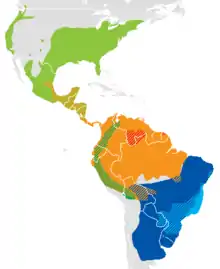| Large American opossums[1] | |
|---|---|
_(3452477057).jpg.webp) | |
| The white-eared opossum, Didelphis albiventris, lives in South America. | |
| Scientific classification | |
| Domain: | Eukaryota |
| Kingdom: | Animalia |
| Phylum: | Chordata |
| Class: | Mammalia |
| Infraclass: | Marsupialia |
| Order: | Didelphimorphia |
| Family: | Didelphidae |
| Subfamily: | Didelphinae |
| Tribe: | Didelphini |
| Genus: | Didelphis Linnaeus, 1758 |
| Type species | |
| Didelphis marsupialis | |
| Species | |
| |
 | |
Didelphis is a genus of New World marsupials. The six species in the genus Didelphis, commonly known as Large American opossums, are members of the opossum order, Didelphimorphia.
The genus Didelphis is composed of cat-sized omnivorous species, which can be recognized by their prehensile tails and their tendency to feign death when cornered. The largest species, the Virginia opossum (Didelphis virginiana), is the only marsupial to be found in North America north of Mexico. The Virginia opossum has opposable toes on their two back feet.
Phylogeny
Cladogram of living large American opossums, the genus Didelphis:[2][3]
| |||||||||||||||||||||||||||||||
Species
| Image | Scientific name | Distribution |
|---|---|---|
_(3453285470).jpg.webp) | Didelphis albiventris | Argentina, Bolivia, Brazil, Paraguay, and Uruguay |
 | Didelphis aurita | Argentina, Brazil and Paraguay. |
 |
Didelphis imperfecta | Brazil, Suriname, French Guiana and Venezuela. |
 | Didelphis marsupialis | northeast of Mexico to Bolivia to the central coast of Peru, including Trinidad and Tobago |
 | Didelphis pernigra | Venezuela to Bolivia |
 | Didelphis virginiana | Central America and North America from Costa Rica to southern Ontario |
References
- ↑ Gardner, A. (2005). Wilson, D.E.; Reeder, D.M. (eds.). Mammal Species of the World: A Taxonomic and Geographic Reference (3rd ed.). Johns Hopkins University Press. p. 5. ISBN 978-0-8018-8221-0. OCLC 62265494.
- ↑ Upham, Nathan S.; Esselstyn, Jacob A.; Jetz, Walter (2019). "Inferring the mammal tree: Species-level sets of phylogenies for questions in ecology, evolution and conservation". PLOS Biol. 17 (12): e3000494. doi:10.1371/journal.pbio.3000494. PMC 6892540. PMID 31800571.
- ↑ Amador, Lucila I.; Giannini, Norberto P. (2016). "Phylogeny and evolution of body mass in didelphid marsupials (Marsupialia: Didelphimorphia: Didelphidae)". Organisms Diversity & Evolution. 16 (3): 641–657. doi:10.1007/s13127-015-0259-x. S2CID 17393886.
External links
Wikimedia Commons has media related to Didelphis.
Wikispecies has information related to Didelphis.
This article is issued from Wikipedia. The text is licensed under Creative Commons - Attribution - Sharealike. Additional terms may apply for the media files.